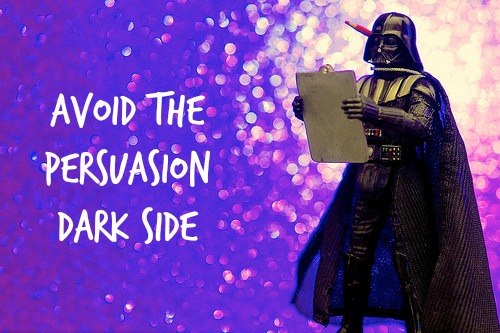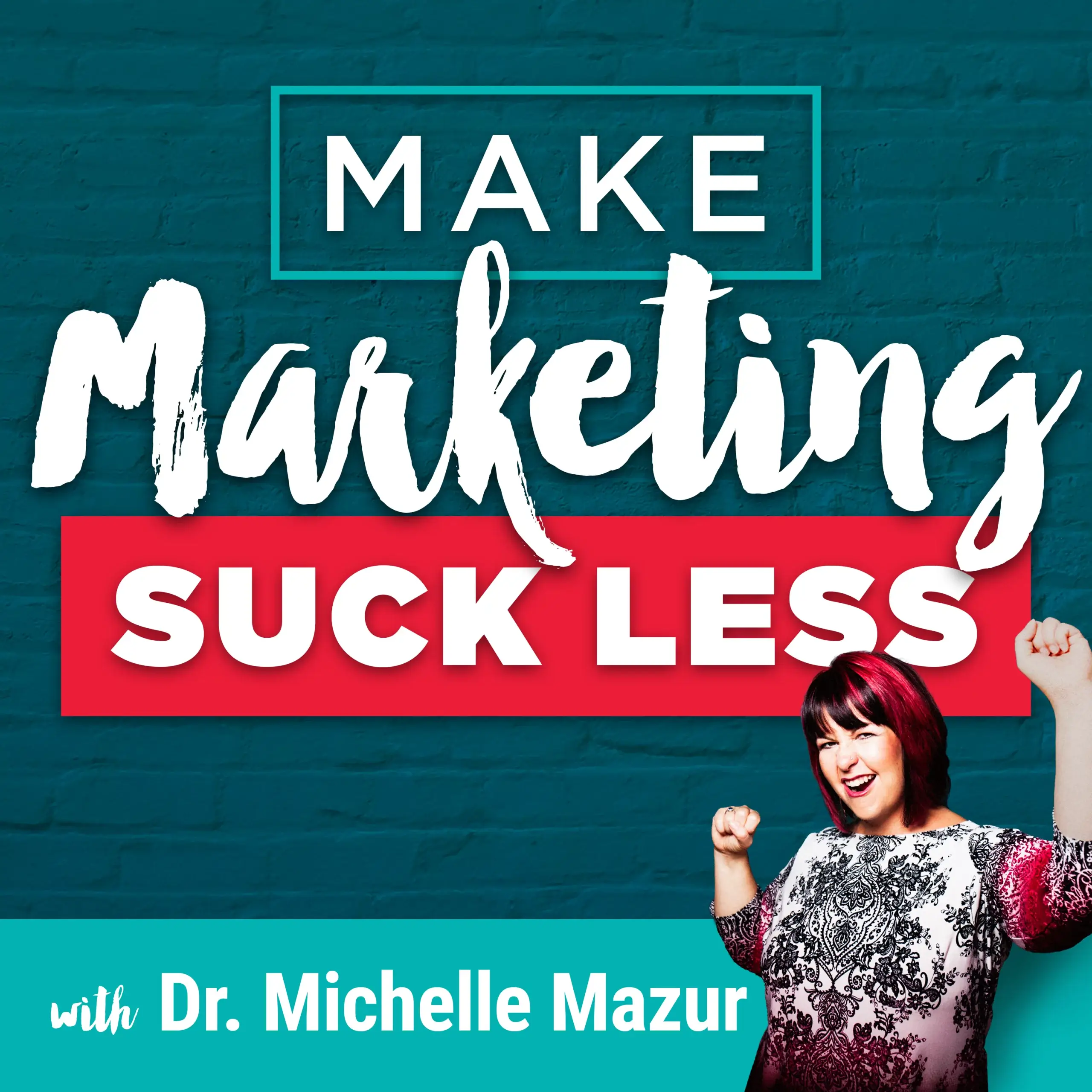Make Marketing Suck Less
Avoid the Persuasion Dark Side in Your Next Presentation
By Michelle Mazur > October 6, 2015
Filed Under Communication
I was 5-years old when my parents took me to the movie theatre for the first time. Nestled in my seat as the movie began, my mom whispered in my ear words that appeared on the screen, “A long time ago, in a galaxy far far away…”
Yep, the first movie I ever went to was Star Wars. A questionable parenting move taking a 5 year old to see that movie because Darth Vader scared the bejebus out of me.
My love affair with Star Wars began that day. As I got older, I became fascinated with The Force. Why did The Force do good for Luke Skywalker and Yoda and evil for Vader? This question perplexed my young mind.
As an adult, I know The Force is neutral. It’s not good. It’s not bad. It’s how you use The Force that makes it dark or light.
You’re probably thinking, “Thanks Michelle for this stroll down Star Wars memory lane, and all the epiphanies you’ve had, but what does this have to do with persuasion and speaking?”
Persuasion is exactly like The Force. It’s neutral. It’s how you use the persuasive techniques that make it good (ethical) or bad (manipulative).
A lot is written about persuasion. You can grab a course that will teach you a formula that pulls on people’s persuasive levers so that you can sell effectively from the stage, write a persuasive email, or navigate tricky sales conversations.
For all the chit-chat about persuasion, rarely is the ethics of persuasion discussed. Persuasion used ethically is an amazing tool. It’s powerful. It brings about change in people’s lives. It serves.
Persuasion when used as manipulation to get a “prospect” to buy whether or not your product or service does provide value to them is destructive. It destroys reputations, trust, and financial well being.
As Obi Wan said, “The Force can have a strong influence on the weak-minded.”
If you ever bought something in a moment of frenzy, only to go home and regret it instantly, you’ve experienced the dark side.
If you’ve ever read about a persuasive tactic that made you feel icky inside or followed a formula, stood on a stage making an offer to buy now when really you should have been seeking buy-in, you’ve experienced the dark side of persuasion.
Young Jedi, there is way to avoid the persuasion dark side in your next presentation by asking two questions.
#1 Does my offer benefit and provide value to my audience?
My friend and colleague, Breanne Dyck says “When you make an offer, you make a promise.”
I don’t care if that offer is for something that is 100% free or cost $20,000, when you offer something, you’re making a promise to the audience.
Can you deliver on that promise?
If you’re like “heck yes, I can,” then ask yourself this “does the offer benefit the audience more than it benefits you?”
If your answer is 100% yes to both, congratulations you’re on the light side of the force. Huzzah.
If you feel any hesitation, sit with it and ask yourself why.
It might be that it’s simply the wrong offer for that crowd or it’s too soon in your relationship with that person to make that type of request. Whatever the reason, adjust your ask until you are comfortable with it’s integrity..
Integrity is the clear path to the lightside of The Force.
The next thing to ask yourself is this:
#2 Is this persuasive technique natural?
There are a lot of possible levers to pull when you persuade a gal. Scarcity, social proof, liking, trust, logic, evidence. The list goes on and on (and we’ll be tackling some of those this month).
But how do you know which ones to use and which ones get you into murky ethical waters?
Ask yourself if the persuasive lever you want to pull is naturally occurring or contrived?
Let’s take our good friend scarcity as an example. Scarcity is very persuasive technique. It increases the urgency and taps into the fear we all have of missing out on something wonderful/necessary/meaningful/exciting.
Some persuasive offers have scarcity built in naturally. If you’re offering an class, and there’s only 10 spots available, then that’s scarcity that is naturally occurring. Use it to your heart’s content.
Then there’s fake scarcity. For instance, I’ve seen offers for digital downloads where there were only 50 available. Umm. It’s a PDF. You can download that bad boy as many times as you want. That’s fake scarcity.
A friend of mine bought a ticket to a workshop because the host said “There’s only 5 spots remaining.” She showed up to the event to see rows of empty chairs. There were more like 50 spots available. Her trust was understandably shattered.
Fake scarcity is deceptive. It’s unethical. It ruins reputations.
Any technique that uses contrived information or feelings has the same negative consequence.
When you’re tempted to add some persuasive appeals because a guru told you to do so or because you hear that it works, don’t do it if it makes you uneasy or seems contrived.
Step into the light. Answer these questions. Persuade in a way that feels good. That is true to you and serves the audience.
As Yoda said to Luke, “If once you start down the dark path, forever it will dominate your destiny.”
I’d add your reputation as a speaker too.
Use The Force Luke, but be responsible about it.
Create Your One-of-a-Kind Message
Your 3 Word Rebellion is the Key to Growing Your Business & Impact







